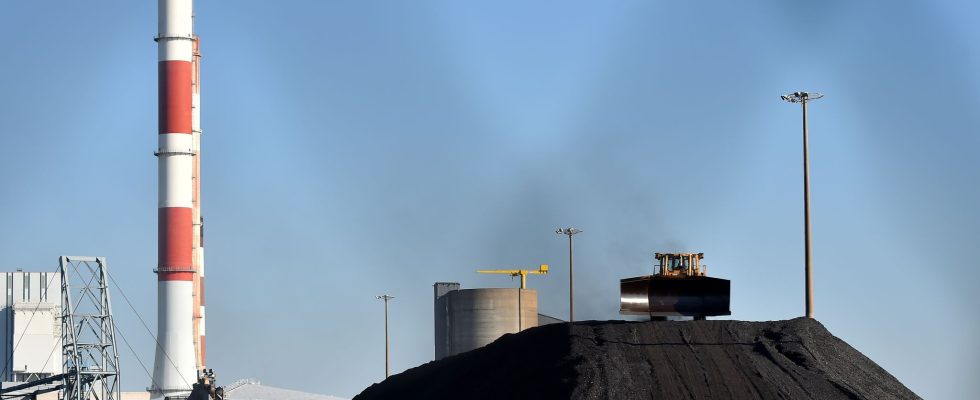Will wood as a source of energy extend the life of our old coal-fired power stations? During his concluding speech to the ecological planning council, Monday September 25, President Macron committed to removing France from this fossil energy that emits high greenhouse gases in 2027. The initial promise, made in 2017, was to close the last coal-fired power plants still operating in France before 2022. But reality has caught up with the head of state. After the interruption of Russian gas supplies and the difficulties encountered by the French nuclear fleet, the operation of two power plants, those of Cordemais (Loire-Atlantique) and Saint-Avold (Moselle), was extended.
Concretely, these two plants only represent a tiny part of the annual electricity production in France, only 0.6% in 2022, according to figures from the Electricity Transport Network (RTE), the network manager. But their contribution is essential to ensure peaks – times when demand increases sharply – and they should continue to play a role in the future, according to RTE’s latest forecast report. By 2030, they could thus be useful if the nuclear fleet did not return to the 2010 level, if the sobriety objectives were not achieved or if the development of renewable energies remained too limited.
The government’s objective is therefore to green these installations by converting them into biomass power plants, in other words, to make them operate using the combustion of wood or wood residue. “There will be a part of the coal which will be replaced by biomass, and which will therefore be renewable energy”, was explained to the office of the Minister of Energy Transition, Agnès Pannier-Runacher. The logic is simple: if a tree emits CO₂ by burning or dying, you just have to replant one so that the carbon dioxide emitted is absorbed again. Thus the resource – wood – will be renewable and carbon neutral.
Retain jobs
This operation to decarbonize fossil fuels goes well with the objective of safeguarding jobs in a sector which is likely to disappear in the coming years. “We were pleasantly surprised by the position taken by the Head of State: no longer hearing about closure but about transformation, that’s reassuring,” comments Fabien Deschamps, CGT union delegate at the Cordemais power plant. For eight years, employees of this EDF site have been fighting to build a credible alternative to its closure by converting it to biomass.
After multiple setbacks – the project was abandoned for a time, before being resurrected – this transformation was validated last January by the Ministry of Ecological Transition. Called “Ecocombust 2”, it provides for the installation of a factory for recycled wood pellets. A partnership has been signed with the Paprec recycling group for the manufacture of pellets from “class B” wood, from furniture and considered as waste. An essential aspect, because many scientists and NGOs consider that this solution generally leads to deforestation and contributes to CO₂ emissions which would not be completely covered by the regrowth of the forest. “The project is well thought out. It will not generate additional pressure on the forests,” concedes Martin Pigeon, head of forest and climate campaigns for the NGO Fern.
“It’s a new technology that will allow us to operate 700 hours per unit per year. It’s less than today, but it will largely meet the network’s needs by 2030,” underlines trade unionist Fabien Deschamps. , in Cordemais.
Transition solution
With 1,000 direct and indirect jobs retained and the creation of 80 positions, according to the CGT, the Cordemais project could well give impetus to the conversion of the other coal-fired power station still in operation, that of Saint-Avold. Operated by GazelEnergie, a subsidiary of the EPH group of Czech businessman Daniel Kretinsky, this unit must also be converted to biomass. But the contours of the project remain unclear. “The technical solution has not been decided, we have presented different scenarios including different proportions of coal and pellet mix in the power plant. The outcome will depend on the decarbonization trajectories chosen by the Ministry of Energy Transition, and the economic rationality of the project”, we inform GazelEnergie. The first mix tests are planned for this winter, and discussions are underway with the ministry to define the roadmap. Initially, the company wants to achieve the equivalent of a gas power plant in terms of carbon emissions. “But, if we are asked to be more ambitious, we can be,” assures a spokesperson. As for the social aspect, the company declares that it has made a commitment to re-employ all coal employees in new projects.
“The good signal is that Emmanuel Macron has understood that renewable energies are a real substitute for fossil fuels, and that they can power the network during peak periods,” said Jules Nyssen, president of the Renewable Energies Union. Heating, electric cars, industry… The electrification of uses and the increase in demand should give new impetus to our coal-fired power plants.
